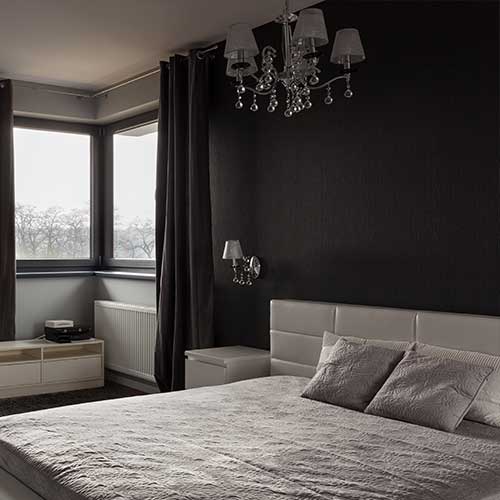
How to Paint A Room Using Dark Colors
While painting with dark colors is trendy, especially now, it does have its downside. Let’s look at how to paint a room with dark colors so the negatives are minimized.
What You Want to Avoid
To minimize the downside, you need to know what you’re up against. One of the major problems with using dark colors to paint a room is the tendency for imperfections to show up more than with the lighter colors. That means if you have ridges from drywall taping, nail holes or other bumps and lumps in the wall, they will be more likely to show up. The solution is to take care of those issues and start with a surface that’s as smooth as possible. Alternatively, you could texturize the wall—we will explain this later.
Also, fingerprints and scuff marks show up more on walls with dark colors Keeping this in mind, you’ll want to paint darker colors in rooms that are less likely to have people touching the walls or just be prepared to do a little extra to keep the walls clean.
Choose a color you can live with for a while. Another drawback of darker colors is that they don’t necessarily have the longevity of lighter shades. People often get tired of the same dark walls after the novelty wears off. Darker shades also fall out of style sooner than their lighter counterparts.
Certain colors can be overwhelming. If the color is too bright it can take away from some of the more interesting aspects of the room, such as the architectural details. Dark colors can make a room seem smaller, which is great if you want to make the room seem cozier and more intimate. On the other hand, dark shades can make the walls recede, so choosing the right color could make the room seem more expansive.
Texturizing Walls for Darker Colors
As mentioned earlier, darker colors are rather unforgiving when it comes to imperfections in the wall. One way to deal with this problem is to add texture. In this way, you can hide defects while adding interest to the walls. There are several ways to add texture to your walls.
Textured paints come in a variety of grades. Some are very coarse, while others are very fine. Some are meant to be used on ceilings, others on walls, and still many can be used on either walls or ceilings. The smooth-textured paints are generally lighter than the others and they provide a subtly textured effect.
There are techniques such as combing and rag rolling to create interesting patterns. Using a sponge to create texture is another approach. You’ll find a variety of strategies to apply a texture to make your walls interesting and unique.
Time to Paint
Be prepared to put on more than one coat of paint to get the deeper color you want. Dark colors often require the wall to be primed for painting. When you apply the paint and it seems more transparent than you want, put on an additional coat. Some colors may take as many as three coats to get the effect you’re looking for.
If your wall is texturized, you will need to apply a primer, otherwise, you could end up putting on several coats of paint. Usually, it takes at least two coats to get the intended color when a primer is used.
If you have a room with a low ceiling, you will want to paint the trim the same color as the walls. This will add depth and make the walls seem taller. You can also hang a mirror on the wall to increase the feeling of depth in the room.
Tape off areas that will not be painted. This will give you a nice smooth finish and a more professional look. Use a paintbrush to fill in the paint around taped areas. Don’t add too much paint in one coat or it could run. Make sure you spread the paint out evenly, so it will look smooth and finished. When you complete the painting around the taped-off area, use a roller to paint the rest of the wall. Don’t worry about the transparency, you’ll add a coat or two to get the opaqueness you want.
Don’t Be Afraid to Experiment
Working with dark colors can feel intimidating at first, so if you like the idea of painting a room a dark color but aren’t sure if you really want to make a full commitment, paint a small room first. Bright-colored accents can really make a room with dark walls look dramatic. Once you get used to the color and begin experimenting with accents and furniture, you may want to take on painting a larger room with a dark color.
If you’re considering painting a room a dark color, consult with professional painters in Arizona, or Nevada to handle the painting for you. The Painting Company will paint your room a dark color that will meet your expectations of this complex paint project. Contact us for information and an estimate.
